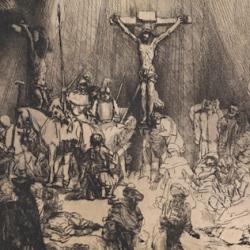Ted Grimsrud’s Instead of Atonement attempts to tells the “Bible’s salvation story” without appeal to the “logic of retribution.” Sacrifice, he says, was not about retribution but about the worshipers grateful response to God’s saving acts; it doesn’t change God’s attitude toward us, and neither does the death of Jesus. The logic of mercy, rather than the logic of retribution, governs the salvation story.
Very late in the book, he acknowledges that “my focus has been limited in my treatment of biblical themes” (233). He concedes that the Bible does talk about God punishing sin, though he thinks it’s an old-fashioned way of speaking about “a natural and impersonal process” (235). He admits that there is a retributionary element to Scripture, tough it is “secondary in the overall biblical perspective; mercy is central” (236). But then it is hard to see how he has proposed something “instead of atonement,” for every retribution theory of the atonement sees mercy as the ultimate origin and restoration as the ultimate end of the salvation story.
So, I’m unconvinced by some of the large sweeps of Grimsrud’s book. But he has many valuable things to say along the way. His description of Pilate’s efforts to manipulate the Jews, using Jesus to squeeze “a public affirmation of the current arrangement” and “a public confession from the chief priests of the emperor’s sovereignty” is clever an illuminating (107-8). He sees Jesus’ conflicts with the Pharisees not as Torah v. anti-Torah, but as conflicts about the proper reading of Torah, and he helpfully argues that the “boundary-keeping” role of Torah is a post-exilic distortion of Torah’s original intentions. The Pharisees had to kill Jesus because the survival of the covenant community “required strict adherence to the Law as they interpreted it. Violations of the law, if left uncorrected, threatened the community’s survival.” Loyalty to the covenant required “strict cultural exclusivism, with clear lines of demarcation between insiders and outsiders.” When Jesus crossed those lines, he threatened the whole Pharisaic program for Israel’s future (125).
Grimsrud gives this summary of the salvation strategy and story of Jesus: “(1) He welcomed all people even across the boundary lines of the cultural exclusivists. (2) He reiterated the core message of Torah concerning God’s mercy and human responsibility. (3) He directly challenged the Powers of cultural exclusivism, religious institutionalism, and political authoritarianism and sought to loosen their holds on people’s loyalties. (4) He simply proclaimed and demonstrated God’s love. This strategy led to his execution in a terribly public, physically torturous, and humiliating way” (175). He gives more specificity to “powers” than many do, but his description is still vague. Are all forms of exclusion expressions of the powers? All institutional form, all authority?
Salvation doesn’t come by Jesus’ opposition to the powers unto death, but only by virtue of His resurrection. The resurrection is a rebuke to the powers, and a vindication of Jesus’ way. As Grimsrud puts it, “Jesus took sides in his ministry. Had he simply withdrawn into neutrality or affirmation of the present status quo, he would never have faced crucifixion. He stood against the powers by showing partiality toward the vulnerable, the poor, and the outcasts—to the point of putting his life in jeopardy. ‘By raising this Jesus from the dead, God affirmed and effectively enacted the partiality of Jesus’” (176). Because of the resurrection, and only because of the resurrection, the community of disciples reassembled to carry on Jesus way of welcome, His way of Torah-keeping, His challenge to the powers.















